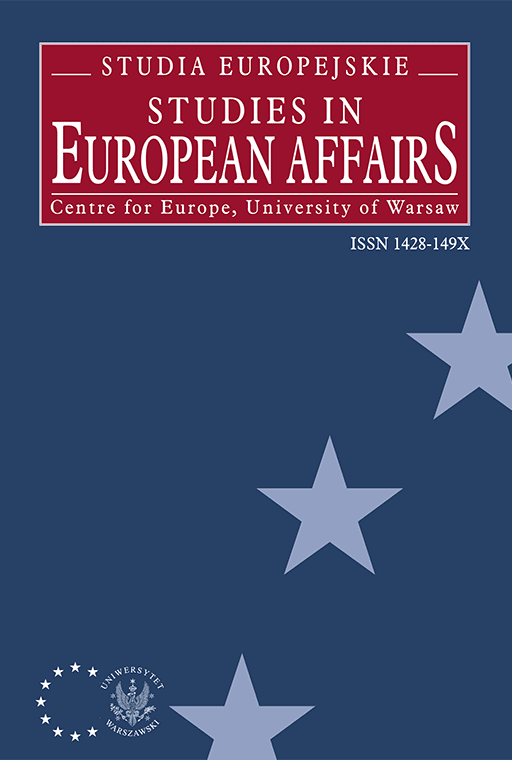
ISSUE: 2/2008
- Volume 46
- Number 2
- 2008
Subscribe NEWSLETTER
Studia Europejskie –
Studies in European Affairs
ISSN: 1428-149X
e-ISSN: 2719-3780
License
Articles published in the journal are under a Creative Commons Attribution – Non Commercial – No Derivatives 4.0 International License
Tendencje na rynkach finansowych a polski złoty – ujęcie jakościowe
Tendences in financial markets and Polish Zloty – qualitative approach
Abstract
The article analyses changes taking place in financial markets over the recent decade, concerning a relationship between the U.S. Dollar which has still retained the role of the world’s most important currency Chinese currency which aspires to the role of one of fundamental global currencies in future financial architecture of the world. The Authors examine potential influence of that relation upon the condition of Polish Zloty and that of the Euroland. According to them, the most evident changes include, among other things, constant depreciation of USD in relation to Euro and other currencies, both international and those with limited exchangeability, such as Polish Zloty, as well as an ever-increasing balance on the current accounts in the USA-China trade exchange. Whilst up to that point China and other Asian countries and international organisations defended the Dollar, it is not certain at all whether such policy will be carried on in the future. In effect, we may have to deal with a number of various turbulences in financial markets. According to some economists this translates into a potential of global monetary crisis, while others believe the modern world leaves no room for profound monetary crises anymore. This, however, is not meant to say we have become immune to crises on local scale, dangerous to countries and institutions not protected by an umbrella of large economic-monetary groups or countries that possess international currency. The Authors, whilst not forejudging the issue of probability of occurrence of either global or local crises, intend to emphasise some facts and truths, among them the following: the world experiences financial and monetary turbulences from time to time; Poland has not been member of any monetary group; both the Euro itself and the Economic and Monetary Union of the EU. They attempt to answer the question they ask: ”Do we have to deal, at present, with a threat of monetary or financial crises?” The Authors point of the need for Poland to tighten its economic relations with the European Union through the accession to the Euroland, mainly in the context of the problem of safety.
References
Central Bank Survey of Foreign Exchange and Derivatives Market Activity, Basel 2003 – 2007 „Biuletyny Narodowego Banku Polskiego”, Warszawa 2000 – 2007
R.De Grauwe, Unia walutowa. Mechanizmy i zasady funkcjonowania, Warszawa 2003.
R.Dornbusch, Eurofantazje, „Gazeta Bankowa” nr 43/1996.
P.Krugman, Wracają problemy kryzysu gospodarczego, Warszawa 2001.
K.Lutkowski, Problem międzynarodowej nierównowagi płatniczej, „Ekonomista” nr 4/2006.
A.Z.Nowak, K.Ryć, Polska wobec kryzysów walutowych, „Problemy Zarządzania” nr 2/2003A.Z.Nowak, Integracja europejska. Szansa dla Polski?, Warszawa 2002.
A.Z.Nowak, Dylematy polskiej polityki gospodarczej wobec zmian na światowych rynkach finansowych i integracji z Unią Europejską, „Ekonomista” nr 1/2000.
A.Z.Nowak, K.Ryć, J.Żyżyński, Consequences of High Interest Rate Policy in the Process of Disinflation. The Case of Poland, „The Journal of Interdisciplinary Economics” vol. 9/1998.
A.Z.Nowak, K.Ryć, J.Żyżyński, Stabilizujące i destabilizujące skutki integracji gospodarki polskiej z Unią Europejską – ujęcie monetarne, „Studia Europejskie” nr 4/1997.
A.Z.Nowak, Czy światu grozi kryzys gospodarczy?, „Nowe Życie Gospodarcze” nr 16/1998. OECD Economic Outlook 81 database.
R.Portes, H.Rey, The Emergence of the Euro as an International Currency, „Economic Policy” vol. 13, issue 26, April 1998.
K.Rybiński, Globalne nierównowagi, „Ekonomista” nr 4/2006.
K.Ryć, Tendencje kursu złotego a sytuacja polskiej gospodarki, Rządowe Centrum Studiów Strategicznych, Warszawa, grudzień 2002.
R.Schall, Pieniądz i polityka pieniężna, Warszawa 1996.
A.Sławiński, Kryzysy walutowe, Warszawa 2001.
J.Stiglitz, Wizja sprawiedliwej globalizacji, Warszawa 2007.
J.Stiglitz, Globalization and its discontents, New York 2002.
Language: Polish
Pages: 9-29
How to Cite:
Harvard
Nowak, A. and Ryć, K. (2008) "Tendencje na rynkach finansowych a polski złoty – ujęcie jakościowe". Studia Europejskie – Studies in European Affairs, 2/2008, pp. 9-29.